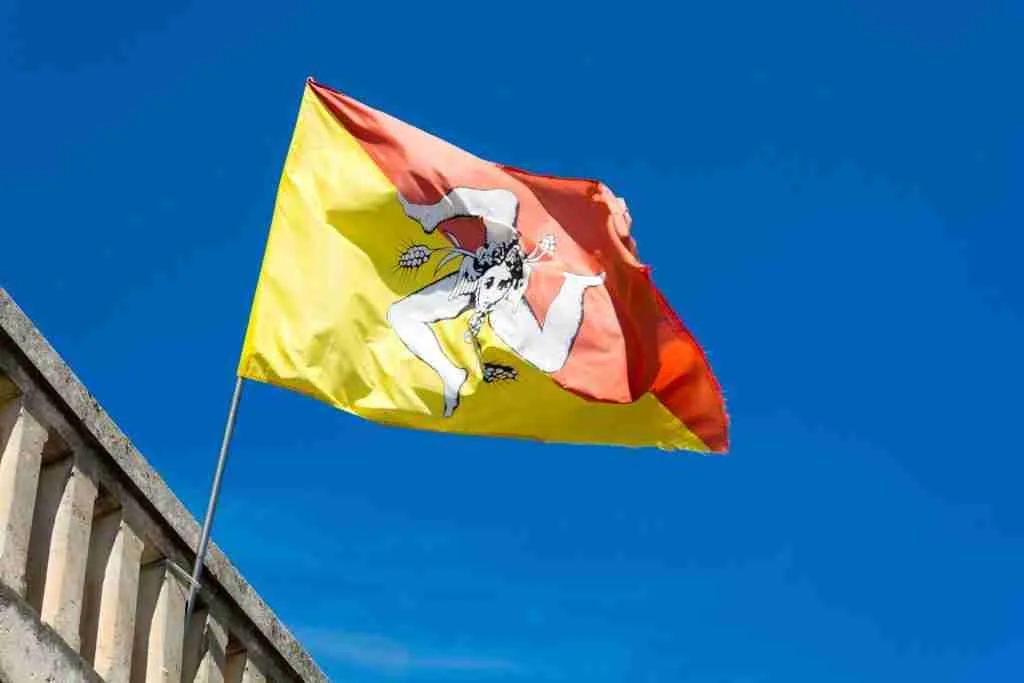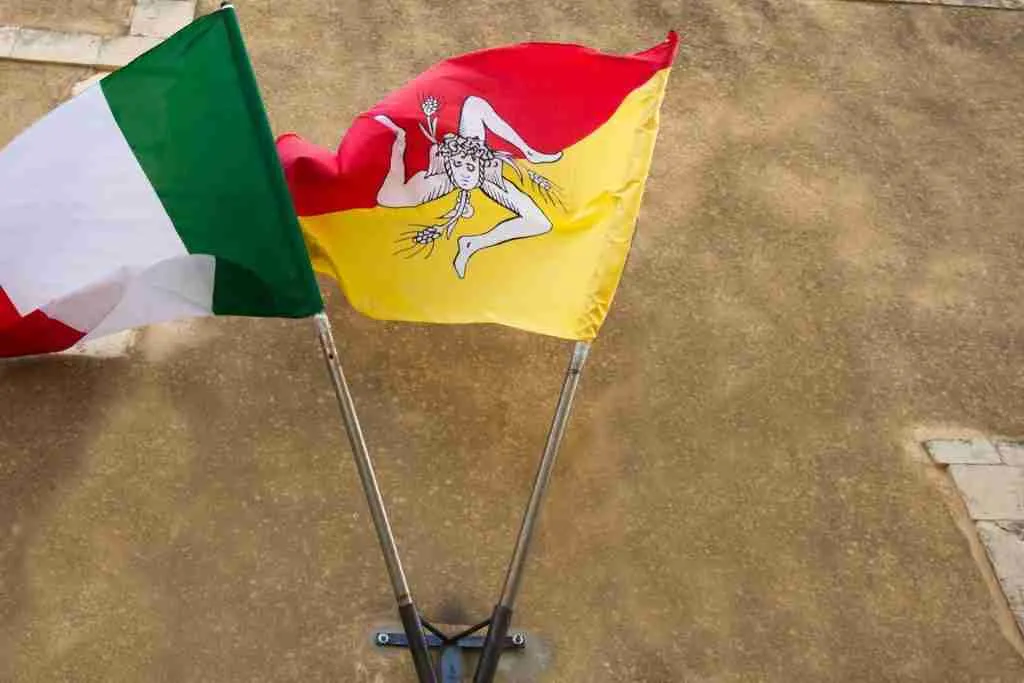The Sicilian flag is a visual feast for the eyes, featuring a triskelion symbol, the head of Medusa with wings, and three wheat ears. But have you ever wondered about the story behind this intriguing flag? Let’s dive deep into the origins and symbolism of the Sicilian flag and uncover its fascinating history. In this content, we’ll discover: unveiling the story of the Sicilian flag symbolism and origins.
“I do not envy God’s paradise because I am so satisfied to live in Sicily.”
Frederick II of Swabia

Unveiling the story of the Sicilian flag: origins
The flag of Sicily traces its roots back to the Sicilian Vespers revolution against King Charles I, which erupted in the 13th century. The red and yellow colors of the flag represent the union of Palermo and Corleone, the first districts to join forces in the fight against the king. It’s like red and yellow were the BFFs of the rebellion, ready to take down the monarchy and party all night long!
Sicilian flag: Symbolism
The Sicilian flag is overflowing with symbolism. The triskelion, with its three swirling legs, symbolizes the three capes of Sicily: Pelorus, Pachynus, and Lilybaeum. These capes form a triangle representing the three valli (valleys) of the island. It’s like Sicily decided to embrace geometry and give it a fashionable twist!
Sicilian flag: rebellion of the Sicilian Vespers
The flag made its grand debut during the rebellious times of the Sicilian Vespers. It was a middle finger to the Roman version of the flag, which was seen as a symbol of submission. The Sicilians didn’t want any part of that! They opted for the Greek version, using wheat ears to represent the prosperity of the land. Who needs to bow down when you’ve got bountiful wheat to make the Roman Empire jealous?

Sicilian flag: Greek and Roman Influence
The use of wheat ears in the Sicilian flag has both Greek and Roman origins. The Greeks initially used wheat ears to depict the prosperity of the land, while the Romans adopted them as a symbol of Sicily’s status as the “Barn of Rome.” As we said, when choosing the flag during the Sicilian Vespers, the Greeks’ version was preferred, rejecting the Roman influence. It’s like Sicily had a preference for the Greek fashion trends and wanted to keep it real and authentic!
Evolution of the Sicilian flag
The Sicilian flag has undergone some changes over the centuries. In the original design, the wheat ears didn’t exist, and the colors were reversed. But as time went on, the flag evolved to showcase its true Sicilian spirit. It’s like a fashion makeover, where Sicily flaunted its unique style and said, “I’m fabulous, and I’m going to rock this flag!”
Over the years, the Sicilian flag went through different changes. It’s as if it wanted to keep up with the changing times. In 1995, a coat of arms adorned the flag, showcasing the Hauteville (Altavilla) family, Manfred’s eagle, the Trinacria, and red bars. But in the year 2000, the current design we know and love was adopted. The wheat ears made their debut, adding a touch of agricultural charm to the flag.
Sicilian flag: Triskelion’s historical significance
As we said, legend has it that the flag’s original design featured a triskeles symbol (you know, those three legs arranged in rotational symmetry) along with the head of Medusa and a pair of wings. But here’s the interesting part: instead of the familiar wheat ears we see today, the flag initially had no such adornments. The design was further enhanced in 1282 during the Sicilian Vespers rebellion.
The triskelion has deep historical roots, reflecting the island’s connection to ancient cultures. It’s said to symbolize the Minoic origins of the first inhabitants of Sicily.
According to Homer, Minos, the hero of Greek mythology, landed in Sicily after leaving Knossos. It’s like Sicily was the go-to vacation spot for ancient legends. No wonder it has such an extraordinary aura!
Sicilian flag: but what about the Gorgoneion and the wheat ears?
Well, the Gorgoneion, with its serpent hair, symbolizes protection and warding off evil. How heroic! And those wheat ears? They represent the extreme fertility of Sicily. It’s like the land is saying, “Hey, look at me! I’m so fertile, I can grow wheat like nobody’s business!” Talk about boasting agricultural prowess.
The head of Medusa, with its fierce expression and a pair of wings, adds a dramatic touch to the Sicilian flag. It’s said to represent protection against evil, as anyone who gazed upon Medusa turned to stone. Talk about having a secret weapon on the flag! And the three wheat ears? They symbolize the exceptional fertility of the Sicilian land. It’s like Sicily is the mother of all grain fields, ready to feed the world!

Sicilian flag: visit the Archaeological Museum of Agrigento
If you’re a flag enthusiast and want to learn more about the Sicilian flag, a trip to the Archaeological Museum of Agrigento is a must. As you wander through the museum, you’ll delve deeper into the intriguing Minoic origins of Sicily. The connection between Minos, Daedalus, and their arrival on the island will leave you mesmerized. It’s like following a labyrinth of myths and legends, with Sicily at the heart of it all. Who knew history could be so exciting.
Here, you can explore the history and significance of the flag in all its glory. Plus, you’ll get to see the first ever triskelion found in Sicily. Made of terracotta and discovered in Palma di Montechiaro, this ancient artifact provides evidence of the Minoic origins of the island’s first inhabitants.
So, there you have it – the story behind the Sicilian flag. It’s a tale of rebellion, symbolism, and ancient origins. The flag proudly represents the unity and resilience of the Sicilian people. Next time you see it flying high, take a moment to appreciate the history and culture it embodies. And hey, maybe even buy a souvenir flag to take home. After all, it’s protected by UNESCO and who wouldn’t want a piece of that in their collection?
The Bottom Line
In this content we talked about unveiling the story of the Sicilian flag symbolism and origins.
The Sicilian flag is not just a piece of cloth; it’s a symbol that resonates with the island’s rich history and cultural identity. From the rebellious spirit of the Sicilian Vespers to the intricate symbolism of the triskelion and the Gorgoneion, the flag tells a captivating tale of legacy and resilience.
The fascinating story of the Sicilian flag is filled with rebellion, prosperity, and ancient mythology. As you roam the streets of this unforgettable land, keep an eye out for the flag waving proudly in the breeze. It is a testament to the indomitable spirit of the Sicilian people and the rich shade of history that has shaped this magnificent island.
The triskeles remind us of the three capes that shaped Sicily’s destiny, while the Gorgoneion with wheat ears symbolizes the island’s prosperity and resilience. The Archaeological Museum of Agrigento offers a glimpse into the flag’s ancient origins and the fascinating world of Sicilian myth and legend. Next time you catch sight of the flag waving proudly in the wind, remember the tales it tells and the exciting spirit of Sicily it represents. Keep following us for more trivia and to find out all about the brand new LCN APP.

